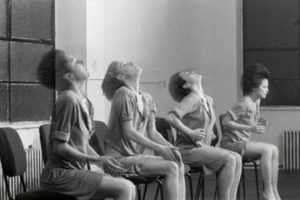 Met dank aan Ingrid van Frankenhuyzen, die dit bericht op facebook zette.
Met dank aan Ingrid van Frankenhuyzen, die dit bericht op facebook zette.
Ook dans wordt bedacht, ondanks het feit dat de VVD de dans als een tak van sport ziet. Welnu: in Amerika weten ze alles van sport, en dus ook van sportief gedrag. Tot op zekere hoogte. Want wat heeft Beyoncé gedaan in haar laatste clip? Juist: een choreografie gekopieerd van de wereldberoemde dansmaakster Anne Terese De Keersmaeker. Haar legendarische ballet Rosas danst Rosas is nu dus door de Amerikaanse megaster voorzien van eigen muziek. Zonder de leverancier van de danspassen te bedanken, te betalen of zelfs maar te nomen. Ze zullen wel gedacht hebben: wie herinnert zich nog een Belgisch ballet uit 1983. Welaan: iedereen in de danswereld herinnert zich dat ballet. Dat wordt dus een vette rekening, die Rosas inmiddels naar Sony heeft gestuurd.
Ter vergelijk dus hier de clip van Rosas
En hier de clip van Beyoncé
Zoek de verschillen.
en hier de overeenkomsten:
Meer bronnen hier: http://readymadebouquet.wordpress.com/2011/10/07/rosas-danst-rosas-and-beyonces-countdown/
We hebben een officiële reactie van Anne Teresa:
Like so many people, I was extremely surprised when I got a message through Facebook about the special appearance of my two choreographies – Rosas danst Rosas (1983) and Achterland (1990) in Beyoncé’s new videoclip Countdown. I was asked if I were now selling out Rosas into the commercial circuit…
When I saw the actual video, I was struck by the resemblance of Beyoncé’s clip not only with the movements from Rosas danst Rosas, but also with the costumes, the set and even the shots from the film by Thierry De Mey. Obviously, Beyoncé, or the video clip director Adria Petty, plundered many bits of the integral scenes in the film, which the videoclip made by Studio Brussel by juxtaposing Beyoncé‘s video and the Rosas danst Rosas film gives a taste of. But this videoclip is far from showing all materials that Beyoncé took from Rosas in Countdown. There are many movements taken from Achterland, but it is less visible because of the difference in aesthetics.
People asked me if I’m angry or honored. Neither, on the one hand, I am glad that Rosas danst Rosas can perhaps reach a mass audience which such a dance performance could never achieve, despite its popurality in the dance world since 1980s. And, Beyoncé is not the worst copycat, she sings and dances very well, and she has a good taste! On the other hand, there are protocols and consequences to such actions, and I can’t imagine she and her team are not aware of it.
To conclude, this event didn’t make me angry, on the contrary, it made me think a few things.
Like, why does it take popular culture thirty years to recognize an experimental work of dance? A few months ago, I saw on Youtube a clip where schoolgirls in Flanders are dancing Rosas danst Rosas to the music of Like a Virgin by Madonna. And that was touching to see. But with global pop culture it is different, does this mean that thirty years is the time that it takes to recycle non-mainstream experimental performance?
And, what does it say about the work of Rosas danst Rosas? In the 1980s, this was seen as a statement of girl power, based on assuming a feminine stance on sexual expression. I was often asked then if it was feminist. Now that I see Beyoncé dancing it, I find it pleasant but I don’t see any edge to it. It’s seductive in an entertaining consumerist way.
Beyond resemblance there is also one funny coincidence. Everyone told me, she is dancing and she is four months pregnant. In 1996, when De Mey‘s film was made, I was also pregnant with my second child. So, today, I can only wish her the same joy that my daughter brought me.
Anne Teresa De Keersmaeker October 10th, 2011
